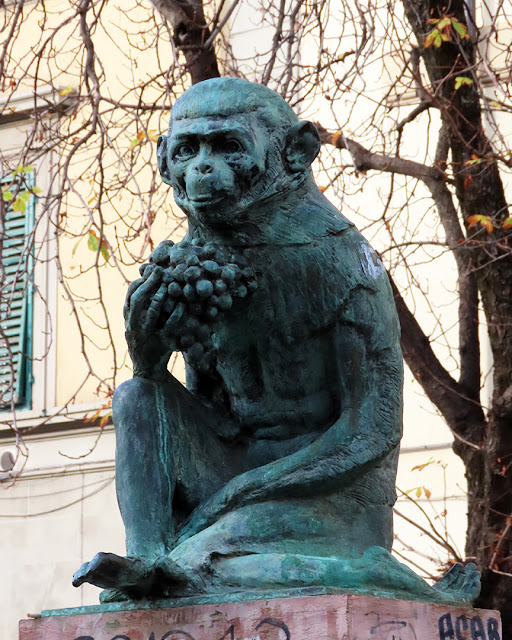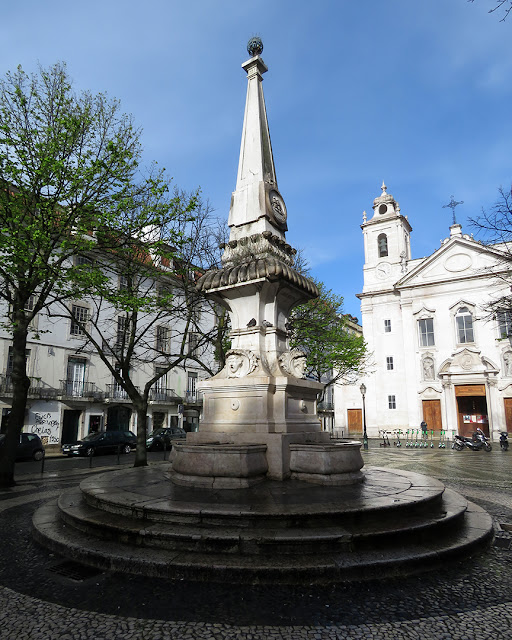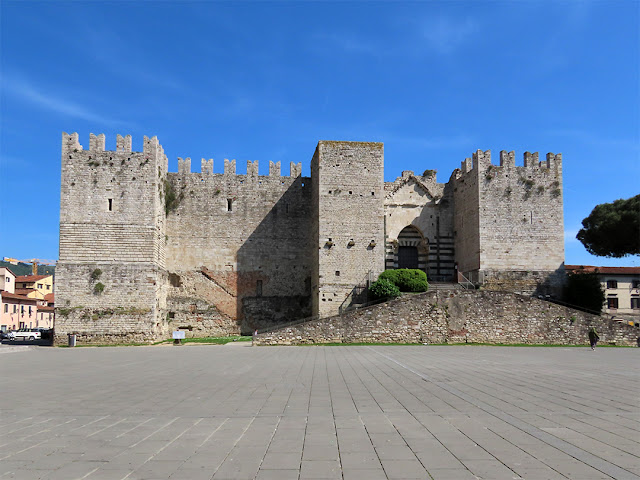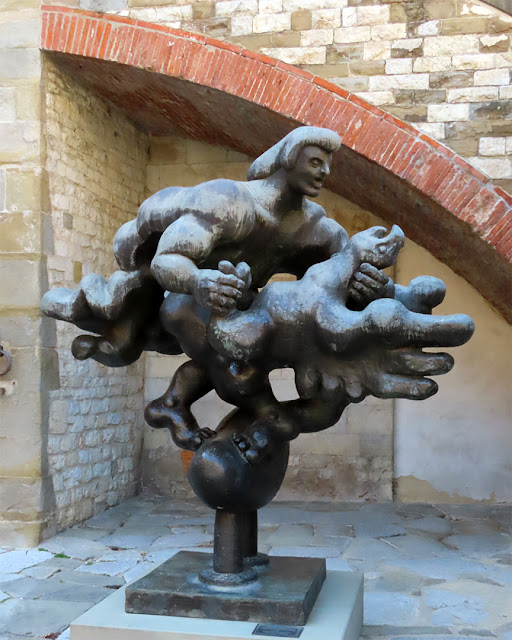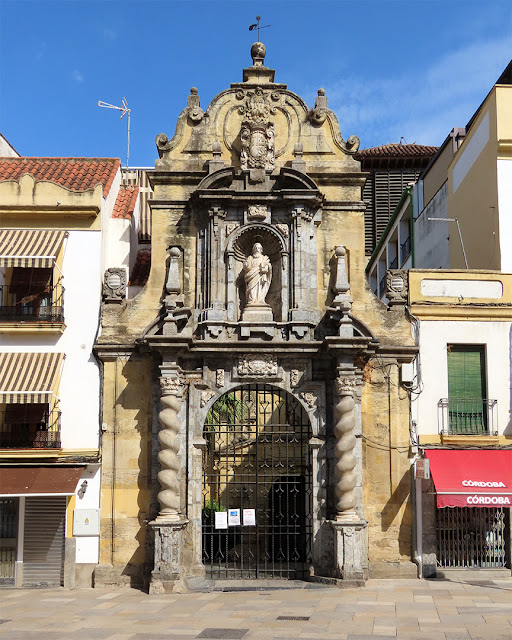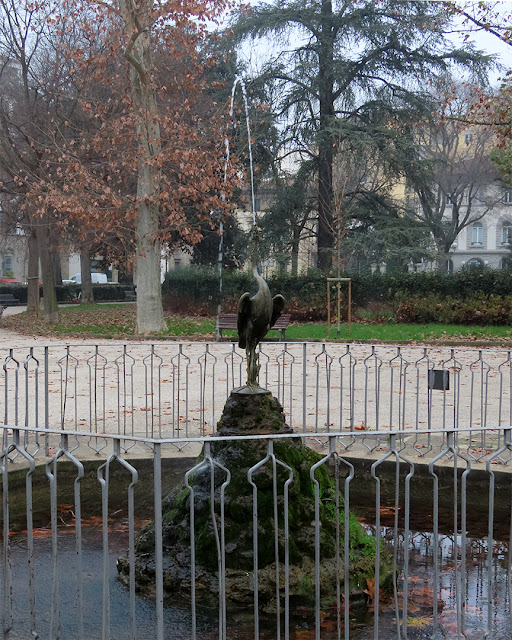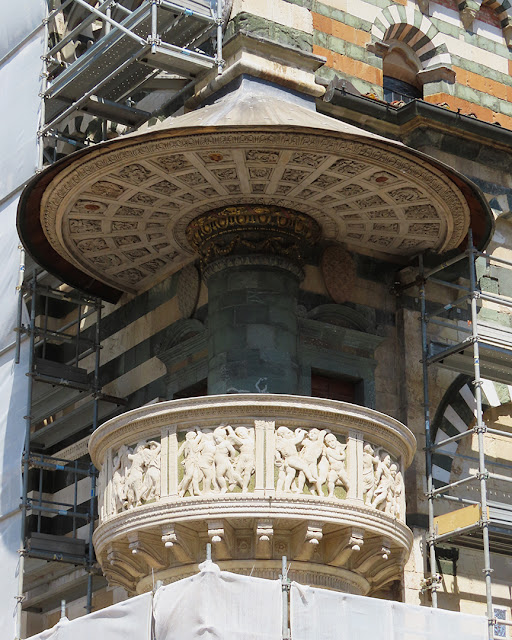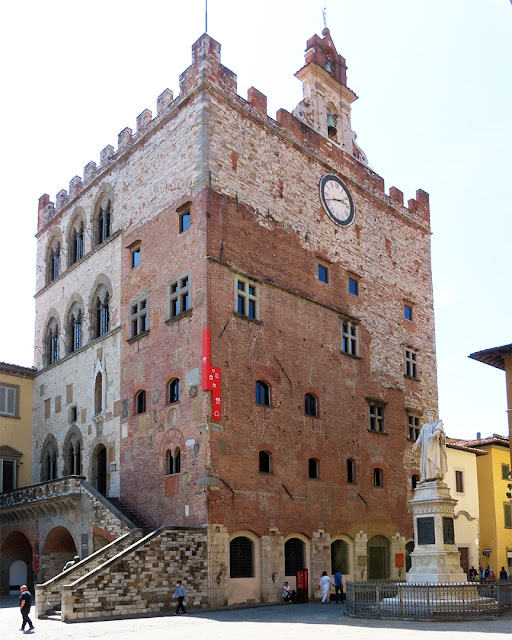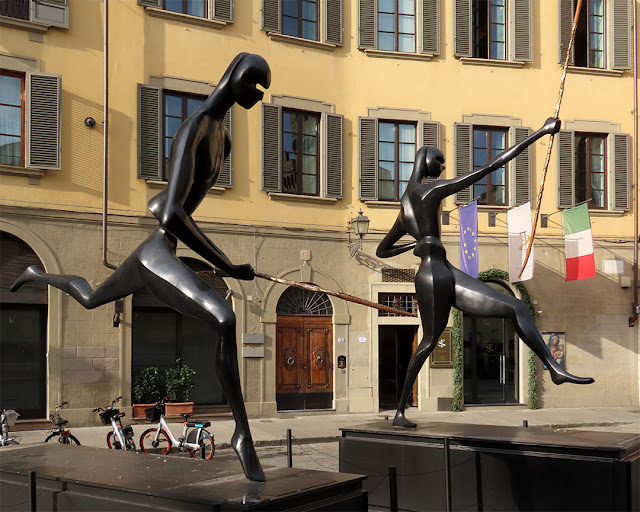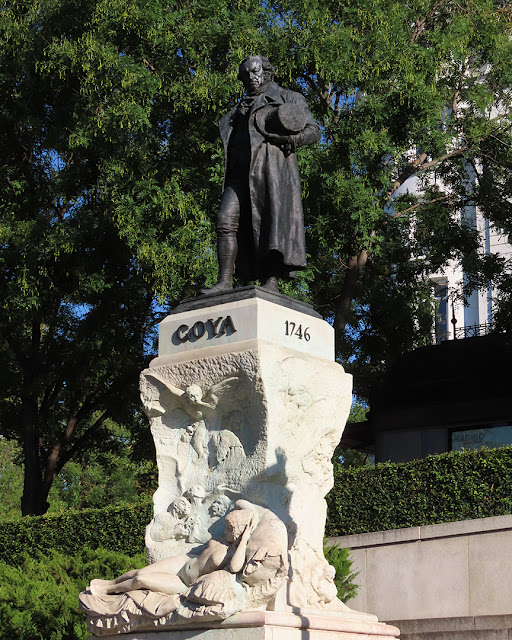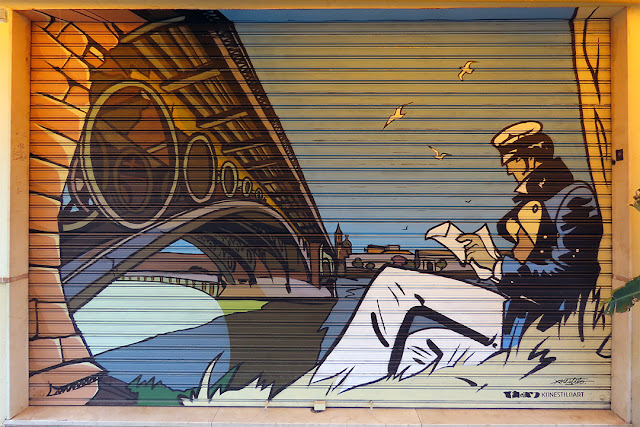Saturday, September 30, 2023
Friday, September 29, 2023
Thursday, September 28, 2023
Castello dell'Imperatore
Castello dell'Imperatore (Emperor's Castle)
Piazza Santa Maria delle Carceri
Prato, May 2022
“A castle with crenellated walls and towers. Built for the medieval emperor and King of Sicily Frederick II, Holy Roman Emperor,[1] it was built in Prato, Italy on top of a previous fortification of which two towers remain. When Frederick II died building was stopped and the interior was never finished. The castle is open to the public and although some destruction took place during the fascist regime, reconstruction work has begun and is ongoing. It is possible to climb the stairs up to the top of the castle walls and walkways for a bird's eye view over the surrounding city of Prato. It was built between 1237 and 1247 by Riccardo da Lentini.” (Castello dell'Imperatore, Wikipedia)
Wednesday, September 27, 2023
Josefskirche am Kahlenberg
St. Josef auf dem Kahlenberg (St. Joseph on Kahlenberg)
Josefsdorf
Vienna, June 2018
“In 1628, Ferdinand II gave a plot of green land on the Josefsberg (also Josephsberg, today known as the Kahlenberg), to the Camaldolite Order. There, they founded their settlement, the Camaldolese Hermitage. Eleven years later, construction was mostly complete but would not be finished until 1683. In that year, St. Joseph’s Church was heavily damaged by fire due to the Second Turkish Siege of Vienna. During this siege, the city was freed by a relief army from there onwards, an event which the church still commemorates in its foyer today. The new construction of St. Joseph’s Church was not entirely completed until 1750. In 1783, it was sold to Leopold Kriegl and consecrated two years later. By 1847, this St. Joseph’s Church had already fallen into extensive ruin, when it was sold to Klosterneuburg after Kriegl went bankrupt. The church was acquired by Johann Finsterle, a Viennese master locksmith in 1852, who then had it restored and rededicated. Since 1906, the chapel has belonged to the Resurrectionists who have renovated it at high cost.” (St. Joseph on the Kahlenberg, Vienna Trips)
Tuesday, September 26, 2023
Monday, September 25, 2023
L'Hemisfèric
L'Hemisfèric by Santiago Calatrava, 1998
Ciutat de les Arts i les Ciències (City of Arts and Sciences)
Valencia, September 2022
“L'Hemisfèric (1998) – an IMAX Cinema, planetarium and laserium. The building is meant to resemble a giant eye, and has an approximate surface of 13,000 m². The Hemisfèric, also known as the planetarium or the ‘eye of knowledge’, is the centerpiece of the City of Arts and Sciences. It was the first building completed in 1998. Its design resembles an eyelid that opens to access the surrounding water pool. The bottom of the pool is glass, creating the illusion of the eye as a whole. This planetarium is a half-sphere in a concrete structure 110 meters long and 55.5 meters wide. The shutter is built of elongated aluminum awnings that fold upward collectively to form a brise soleil roof that opens along the curved axis of the eye. It opens to reveal the dome, the "iris" of the eye, which is the planetarium or Ominax theater. The structure is divided in half by a set of stairs that descend into the vaulted concrete lobby. The underground spaces are illuminated with the use of translucent glass panels within the walking path. The transparent roof is supported by concrete arches that connect to the sunken gallery. There is a remarkable echo in the building and if two people stand at the two opposite pillars inside of the eye they can speak with each other.” (City of Arts and Sciences, Wikipedia)
Sunday, September 24, 2023
Prometheus Strangling the Vulture
“Prometheus Strangling the Vulture” by Jacques Lipchitz, 1944
Piazza del Comune
Prato, May 2022
“This sculpture is an adaptation of the story of the Titan Prometheus, who stole fire from the gods and gave it to humans. According to Greek mythology, Zeus, the king of the gods, was infuriated by Prometheus’s action, and he sent an eagle to pluck out the liver of the audacious rebel. In Jacques Lipchitz’s version, Prometheus turns on his tormentor (transposed to a vulture) and dominates it. The artist executed a monumental version of this work for the 1937 Paris World’s Fair as an allegory of resistance against fascism in Europe, with Prometheus wearing a Phrygian cap, the symbol of democracy. The Philadelphia Museum of Art commissioned this bronze cast of a later reprise of the same theme in 1952. Displayed on the steps of the museum, the triumph of Prometheus, whose gift of fire brought craft and civilization to humanity, stands for an ideal of genius and progress.” (Prometheus Strangling the Vulture, Philadelphia Museum of Art)
Saturday, September 23, 2023
Puerta del Cambrón
Puerta del Cambrón
Paseo Recaredo
Toledo, September 2022
“The Puerta del Cambrón is a gate located in the west sector of the Spanish city of Toledo, in Castile-La Mancha. Also called previously ‘Gate of the Jews’ or ‘Gate of Saint Leocadia’, has been speculated The possibility that the name of the gate, del Cambrón, had its origin in the growth of a thorn bush or plant at the top of the ruins of one of the towers, before the last reconstruction of the gate, In 1576. It has the cataloging of Bien de Interés Cultural. Of Renaissance style, has two pairs of towers and two arches, being built of stone and brick. It underwent two renovations in the early-1570s and in 1576. Hernán González, Diego de Velasco and Juan Bautista Monegro would sculpt a figure of Leocadia in the gate. The gate was little damaged during the Spanish Civil War.” (Puerta del Cambrón, Wikipedia)
Friday, September 22, 2023
Bartolomeo and Lucrezia
Portrait of Bartolomeo Panciatichi, 1540
Portrait of Lucrezia Panciatichi, 1545
By Bronzino (Agnolo di Cosimo)
Uffizi Gallery
Piazzale degli Uffizi
Florence, January 2023
“Lucrezia di Sigismondo Pucci was the wife of Bartolomeo Panciatichi, a Florentine humanist and politician, also portrayed by Bronzino in another Uffizi portrait. Giorgio Vasari describes the two portraits as: ‘so natural that they seem truly living’. The show of refined garments and jewelry was intended not only to underline the élite position of the woman, but also aspects of her personality through a complex symbology, including the words ‘Amour dure sans fin’ on the golden necklace, a reference to a love treatise written for the Grand Duke of Florence, Cosimo I de' Medici, in 1547.” (Portrait of Lucrezia Panciatichi, Wikipedia)
Thursday, September 21, 2023
Felipe III de España
Equestrian statue of King Philip III by Jean Boulogne and Pietro Tacca, 1616
Plaza Mayor
Madrid, September 2022
“There is a bronze statue of King Philip III at the center of the square, created in 1616 by Jean Boulogne and Pietro Tacca. Giambologna's equestrian statue of Philip III dates to 1616, but it was not placed in the center of the square until 1848. The statue was a gift from the Duke of Florence at that time. It was Queen Isabel II ordered to move it from Casa de Campo to become the centerpiece of the Plaza Mayor.” (Plaza Mayor, Wikipedia)
Wednesday, September 20, 2023
Fontana del Pescatorello
Fontana del Pescatorello (also Duck's fountain), 1863
Piazza del Duomo
Prato, May 2022
“The square is surrounded by buildings mostly of fourteenth-century origins. On the south side is the nineteenth-century Palazzo Vestri, in front of which stands the statue of Giuseppe Mazzoni, a Prato politician, realized by Alessandro Lazzerini. Next to the Cathedral is the Bishop's Palace and in front of it the Dragoni Palace, renovated in the nineteenth century. In the middle of the square is the nineteenth-century ‘Fontana del Pescatorello’ named ‘Duck's fountain’ (1863) sculpted by Emanuele Caroni and Ulisse Cambi.” (Cathedral square, PratoTurismo)
Tuesday, September 19, 2023
Iglesia de San Pablo
Iglesia de San Pablo
(entrance from) Calle Capitulares
Córdoba, September 2022
“San Pablo is a church and former convent in Córdoba, Andalusia, southern Spain. The present church and defunct convent were built on a space that always harbored large buildings for its location at the door of the city along one of the main access roads. A Roman Circus predated a Muslim palace before Almohad Christians built a Dominican convent. The church has Baroque features made in marble dating to 1708. The main facade features the Mannerist style of the 16th century. The interior consists of three naves divided by pillars covered with coffered Mudéjar ornamentation. There are three apses, circular on the inside and rectangular on the outside, with a quarter-sphere dome, and central pentagonal vault. The tower is located at the foot of the church and is of stone, upon which stands the wooden bell tower. In the nave of the Gospel, there is a pointed flaring arch, with caliphal capitals, leading into San Pablo Street. In the nave of the Epistle, there is an old door of Gothic-Mudejar style. Among the preserved chapels is the Chapel of the Madonna del Rosario, built in the 15th century and renovated in 1758, which is an example of Baroque Cordoba. Remains of the cloister of the convent can be seen embedded in the passage that leads to the Ministry of Culture on Capitulares Street. The chapter house, designed by Hernán Ruiz II, was possibly unfinished for lack of funds. Restoration and refurbishment of the building occurred in 2008 as part of an earmark for the cultural area of the city. One of the most important sculptures of Easter Cordoba, Our Lady of Sorrows, is by Juan de Mesa and dates to 1627.” (San Pablo, Wikipedia)
Monday, September 18, 2023
Ibis fountain
Ibis fountain (restored in 2012)
Piazza d'Azeglio
Florence, January 2023
“The area around the current Piazza d'Azeglio was expropriated and divided into lots within a regular mesh, lots that were purchased by wealthy bourgeois families and senior state officials, becoming the most modern and exclusive neighborhood in the center. In fact, a characteristic of the square is that all the buildings around it are luxurious buildings and villas of a high architectural level. A cosmopolitan environment was formed, frequented by politicians, intellectuals, artists and musicians who lived or were hosted here and crowded the salons where the ‘important’ public opinion was formed at the time. The name of the square sums up its destiny: the Marquis Massimo d’Azeglio (1798 - 1866) was an important politician, writer, poet and painter. The area was structured in lawns, a hexagonal fountain with a statue of an ibis, patches of plane trees and hackberry (wood from which the whips were then made!), boxwood and laurel hedges. Until 1940, the square was actually ‘private’ because it was surrounded by a high gate of which only the owners of the buildings around had the keys and could use it.” (Piazza Massimo d'Azeglio, Arte Leonardo)
Sunday, September 17, 2023
Don Cammillo e Peppone
Don Cammillo e Peppone restaurant
Calle Betis, Triana
Seville, September 2022
“Don Camillo and Peppone are the fictional protagonists of a series of works by the Italian writer and journalist Giovannino Guareschi set in what Guareschi refers to as the "small world" of rural Italy after World War II. Most of the Don Camillo stories came out in the weekly magazine Candido, founded by Guareschi with Giovanni Mosca. These ‘Little World’ (Piccolo Mondo) stories amounted to 347 in total and were put together and published in eight books, only the first three of which were published when Guareschi was still alive. Don Camillo is a parish priest and is said to have been inspired by an actual Roman Catholic priest, World War II partisan and detainee at the concentration camps of Dachau and Mauthausen, named Don Camillo Valota (1912–1998). Guareschi was also inspired by Don Alessandro Parenti, a priest of Trepalle, near the Swiss border. Peppone is the communist town mayor. The tensions between the two characters and their respective factions form the basis of the works' satirical plots.” (Don Camillo and Peppone, Wikipedia)
Saturday, September 16, 2023
Pulpit by Michelozzo
Pulpit by Michelozzo and Donatello, 1438
Cathedral of Saint Stephen
Piazza del Duomo
Prato, May 2022
“In the early 15th century, a new façade or west front was added in the International Gothic style, in front of the old one. In the space between the two was created a narthex or corridor leading to the external pulpit, built by Michelozzo and decorated by Donatello between 1428 and 1438. The seven original reliefs of the parapet were removed from the pulpit in 1967 and can be seen today in Prato's cathedral museum.” (Prato Cathedral, Wikipedia)
Friday, September 15, 2023
Majolikahaus
Majolikahaus (Majolica House) by Otto Wagner, 1899
Linke Wienzeile 40
Vienna, June 2018
“The most famous of these is the Majolikahaus or Majolica House, at Linke Wienzeile 40. Its facade is entirely covered with majolica, or colorful glazed earthenware tiles in the floral designs which characterized the early Vienna Secession. The facade decoration was made by his student Alois Ludwig. The facade was not only decorative, but had a practical purpose; the tile facade could be easily cleaned by using fire hoses.” (Linke Wienzeile Buildings, Wikipedia)
Thursday, September 14, 2023
Idra and Merope
“Idra” e “Merope” (“Idra” and “Merope”) by Antonio Signorini, 2022
Piazza San Firenze
Florence, January 2023
“In piazza San Firenze, piazza del Carmine and piazza del Grano, horses take flight, dancers leap and long slender figures stretch their way seemingly beyond the very limits of the city’s iconic architecture, streaming with a lightness that casts the eyes upwards as our own bodies seem to stretch taller in response to the grand images. But these are images of contrast; to create flight, the sculptures must be balanced by the solid pressure of a counterweight, yet somehow the bases remain almost invisible, so completely is the eye drawn by the lithe and powerful dancing figures above.” (Antonio Signorini’s Attraverso show, The Florentine)
Wednesday, September 13, 2023
Igreja de São Paulo
Igreja de São Paulo (Saint Paul church)
Praça de São Paulo
Lisbon, April 2019
“The lovely São Paulo Church is situated in the historical centre of cosmopolitan Lisboa, next to the much frequented Cais do Sodré area, since early times a place of trading and commerce. The present temple was rebuilt over a previous church, after it got destroyed with the big Earthquake of 1755 that changed forever the face of Lisboa. In 1768 the restoration works began, according to the Architect Remígio Francisco de Abreu project, inverting the Church’s original orientation and following the typical style of the majestic Mafra Convent. The Church is characterized by its one only nave, two square towers, a rectangular main chapel and eight lateral chapels. The paintings in the Church’s interior are attributed to João Grossi and Pedro Alexandrino de Carvalho, and the ones in the ceiling to Jerónimo de Andrade. The façade shows proudly the image of the ‘Saint Paul’s Conversion’ and the images of Saint Paul and Saint Peter.” (São Paulo Church, Guia da Cidade)
Tuesday, September 12, 2023
Palazzo Pretorio
Palazzo Pretorio
Piazza del Comune
Prato, May 2022
“The Palazzo Pretorio is a historical building in Prato, Tuscany, italy. It was the old city hall, standing in front of the current Palazzo Comunale. It now accommodates the Civic Museum of Prato, which was reopened in September 2013. The main structure in its present form was assembled during the late 13th century and early 14th century from the merger of three separate buildings, fused to house the local podestà, the judiciary and Prison. The different building materials, evident from the facade, still reveal the outlines of the earlier structures. The oldest part is the tower-house still discernible on the right (13th century), which had belonged to the family of Pipini, with a portico on the ground floor with pilasters of limestone then buffered but still visible. It was purchased in 1284 from the ‘capitano del popolo’ Fresco Frescobaldi to house the municipal government. During the 16th century, the building, including the belltower, collapsed. The restoration added a new bell tower and crowning crenellations. The interiors were often divided into smaller rooms over time. Towards the end of 19th century, it was proposed for demolition, but by 1909 it was decided to restore the building. The left hand part of the facade and building dates back to the 14th century and has eight elegant mullioned windows and a tabernacle. In this tabernacle, until at least 1799, stood a statue of the 14th century Robert of Anjou, once viewed as a defender of the city. Unfortunately, it was he, who sold Prato to Florence, ending the town's independence.” (Palazzo Pretorio, Wikipedia)
Monday, September 11, 2023
L'Àgora
L'Àgora (The Agora) by Santiago Calatrava, 2009
Ciutat de les Arts i les Ciències (City of Arts and Sciences)
Valencia, September 2022
“In early 2018, the Catalan architect Enric Ruiz-Geli was announced to be the winner of a private architecture competition to build the new CaixaForum Valencia inside L'Àgora. CaixaForum Valencia will adapt 6,500 square meters to house two exhibition halls, an auditorium with 300 seats, two multipurpose rooms, a bar-restaurant, a bookstore, and family and educational space on a second level. The space will offer art exhibitions, conferences, concerts and shows, social events, educational and family workshops and activities for the elderly. An investment of around 18 million euros is needed to renovate L'Àgora to house CaixaForum Valencia. In addition, about 5 million euros may be allocated annually for the maintenance, programming and operation of the center. It is expected to open in early 2021.” (L'Àgora, Wikipedia)
Sunday, September 10, 2023
The guardians
“Il guardiano del cielo” and “Il guardiano della fede”
(“The guardian of the sky” and “The guardian of the faith”) by Antonio Signorini, 2022
Piazza San Firenze
Florence, January 2023
“In piazza San Firenze, piazza del Carmine and piazza del Grano, horses take flight, dancers leap and long slender figures stretch their way seemingly beyond the very limits of the city’s iconic architecture, streaming with a lightness that casts the eyes upwards as our own bodies seem to stretch taller in response to the grand images. But these are images of contrast; to create flight, the sculptures must be balanced by the solid pressure of a counterweight, yet somehow the bases remain almost invisible, so completely is the eye drawn by the lithe and powerful dancing figures above.” (Antonio Signorini’s Attraverso show, The Florentine)
Saturday, September 9, 2023
Juan de Padilla
Juan de Padilla by Julio Martín de Vidales, 2015
Plaza de Padilla
Toledo, September 2022
“Juan de Padilla (Toledo, November 10, 1490 - Villalar, April 24, 1521) was a Castilian nobleman, known for his decisive participation in the War of the Communities of Castile, in which he supported the rebel side in arms against the monarch Charles I. He died beheaded after the communal defeat in Villalar.” (Juan de Padilla, Wikipedia)
Friday, September 8, 2023
Church of San Francesco
Church of San Francesco
Piazza San Francesco
Prato, May 2022
“San Francesco is a Gothic-style, Roman Catholic church located in front of the square named after the church, in the historic center of Prato, region of Tuscany, Italy. San Francesco’s church, in the homonym square (XII–XIV sec.), it is located in the nucleus of the Oldest City of Prato and an Important Place of Catholic worship and one of the first Franciscan Churches with his big convent built on the ground that was donated by the municipality to the friars minor only eight days after the canonization of the saint, in 1228.” (San Francesco, Wikipedia)
Thursday, September 7, 2023
Wednesday, September 6, 2023
Ponte all'Indiano
Ponte all'Indiano (Indiano Bridge) by Fabrizio de Miranda, 1978
Seen from the Cascine Park
Florence, January 2023
“Indiano Bridge (Ponte all'Indiano in Italian) is the first earth-anchored cable-stayed bridge in the world. It is a bridge across the Arno River in Florence (Italy) near the Indian Monument of Rajaram II. The bridge was built between 1972 and 1978 by Società C.M.F. S.p.A. with architectural and urban architects Adriano Montemagni and Paolo Sica, and structural design engineer Fabrizio de Miranda. The project won the national competition organized by the Municipality of Florence in 1968, and immediately attracted attention because it involved a pedestrian bridge hanging below. For the structural characteristics Fabrizio de Miranda in 1978 received the European award-CECM ECCS (European Convention for Construction Metallica). In fact it is the first cable-stayed bridge of large span anchored to the ground made the world and is one of the largest cable-stayed bridges in Italy of the twentieth century.” (Indiano Bridge, Wikipedia)
Tuesday, September 5, 2023
Padre Cosme Muñoz Pérez
Padre Cosme Muñoz Pérez (1579-1636) by José María Serrano Carriel, 2008
Plaza de las Cañas
Córdoba, September 2022
“Cosme Muñoz Pérez, known as Father Cosme, religious born in Villar del Río (Soria) on April 19, 1573 and died in Córdoba on October 3, 1636. Father Cosme dedicated his life to the Colegio de la Piedad, a teaching center where orphaned girls received a comprehensive education, to fend for themselves. Despite the fact that the center had been created by Isabel de la Cruz, Father Cosme was the true founder of the center. Likewise, he is one of the founders of the Congregation of the Daughters of the Patronage of Mary.” (Padre Cosme, Córdobapedia)
Monday, September 4, 2023
Santa Maria delle Carceri
Santa Maria delle Carceri
Piazza Santa Maria delle Carceri
Prato, May 2022
“Santa Maria delle Carceri is a basilica church, designed by Giuliano da Sangallo, and built in Prato, Tuscany, Italy. It is among the earliest examples of a Greek cross plan for a complete church in Renaissance architecture. According to the tradition, on July 6, 1484, a painted image of Madonna and Child, located on a wall of the public jail (carceri) of Prato, began to animate itself in the eyes of a local child. It was therefore decided to build a basilica on that site to celebrate the event. Lorenzo de Medici, lord of the Republic of Florence, imposed a design by his favourite architect, da Sangallo. The latter's proposal included a Greek cross plan inspired to Filippo Brunelleschi's Pazzi Chapel and by Leon Battista Alberti's theoretical works; Sangallo used the same idea for his first project of St Peter's Basilica, later superseded by Michelangelo. The same model inspired his brother Antonio da Sangallo the Elder for the church of San Biagio at Montepulciano. The interior of the church was completed from 1486 to 1495, while the exteriors remained unfinished in 1506. The upper part of the western arm was completed in the late 19th century following Sangallo's design.” (Santa Maria delle Carceri, Wikipedia)
Sunday, September 3, 2023
Saturday, September 2, 2023
Fyodor Dostoevsky
Fyodor Dostoevsky by Aidyn Zeinalov, 2021
Viale Washington
Parco delle Cascine (Cascine Park)
Florence, January 2023
“Dostoevsky travelled to western Europe for the first time on 7 June 1862, visiting Cologne, Berlin, Dresden, Wiesbaden, Belgium, and Paris. In London, he met Herzen and visited the Crystal Palace. He travelled with Nikolay Strakhov through Switzerland and several North Italian cities, including Turin, Livorno, and Florence. He recorded his impressions of those trips in Winter Notes on Summer Impressions, in which he criticised capitalism, social modernisation, materialism, Catholicism and Protestantism.” (Fyodor Dostoevsky, Wikipedia)
Friday, September 1, 2023
Chafariz do Carmo
Chafariz do Carmo (Carmo Fountain)
Largo do Carmo
Lisbon, April 2019
“One of the several – and most remarkable – public fountains built in Lisbon through the 15th-18th centuries, the Chafariz do Carmo sits in the Largo do Carmo plaza, beside the convent of the same name. Of late Baroque architecture, the fountain is enclosed within a porch supported by four majestic pillars and was raised on an aqueduct that once carried water to the city. Purely decorative today, it certainly adds to the place's atmosphere and is worth having a quick look-see” (Chafariz do Carmo, GPSmyCity)
Subscribe to:
Posts (Atom)

